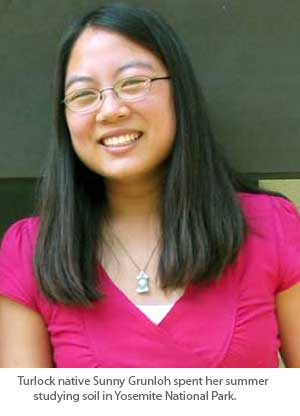

When UC Merced senior Sunny Grunloh set out to learn about black carbon - soot and char, for example - in soils after prescribed burns in Yosemite National Park this summer, she had no idea she was in for a big logistical challenge. She just knew she was getting the opportunity more than a hundred other students had applied for without success - participating in the National Science Foundation-funded Research Experiences for Undergraduates Program in Yosemite.
That was exciting enough, and Grunloh signed on without hesitation.
Grunloh had come to UC Merced from nearby Turlock, where her parents, a teacher and a nurse, brought her up to plan on a college education. But she knew teaching or nursing weren’t the right choices for her.
“I considered a lot of options, and environmental science felt right,” she said.
UC Merced was the perfect choice for her desired course of study. A thriving environmental sciences research program through the Sierra Nevada Research Institute, undergraduate majors in environmental engineering and Earth systems science, and strong connections with Yosemite and Sequoia/Kings Canyon National Parks gave Grunloh lots of choices.
This summer, she took advantage of the chance to get involved with UC research during her undergraduate career and study the effects of wildfire on soil.
In a normal summer, prescribed burns may occur regularly - helping keep down undergrowth and “tree trash” - fallen twigs and needles, for example - that keep new trees from growing. But this summer, things were different. With an unusually large number of natural fires in the Sierra Nevada, forest managers did not proceed with their normal schedule of prescribed burns. So it was challenging for Grunloh and her research mentors - grad student Gyami Shrestha and Professor Sam Traina - to get the samples they needed to analyze black carbon in the soil.
But scientists are nothing if not innovative. Instead of working with samples of burned-over soil from nature, Shrestha and Grunloh came up with a method of re-creating the effects of a controlled burn in the laboratory. They collected samples of unburned soil and debris, then burned the samples in a furnace to analyze the effects.
Most importantly, though, Grunloh became acquainted with an important aspect of science related to global climate change. Black carbon may account for 10 to 80 percent of the total carbon produced when plant material is burned. The remaining percentage is released into the atmosphere as carbon dioxide. A better understanding of this process may help our advance toward more climate-friendly energy.






